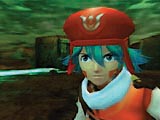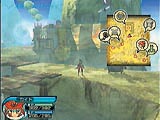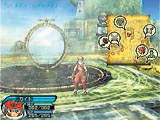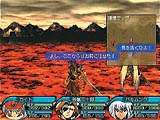
| Platform: PlayStation 2 | Publisher: Bandai |
| Genre: Turn-Based Virtual Online RPG | Developer: Cyber Connect 2 | Format: DVD-ROM & anime OVA DVD | Expected Release: Feb. 2003 |
Bandai’s most promising title this year at E3 was without a doubt .hack for the PlayStation 2. Billed as an "offline" MMORPG (Massively Multiplayer Online Role Playing Game), .hack strides into very unique waters. How exactly does an offline MMORPG work you may ask? North American gamers will have wait until the October for those answers when Bandai releases of the first of .hack’s four installments. In an odd twist of concept, .hack is a game within a game, or more precisely, an MMORPG that is played within the game's actual story. Developed by CyberConnect2, the .hack team consists of anime industry veterans including Yoshiyuki Sadamoto (character designer of Neon Genesis Evangelion) and Kazunori Ito (screenwriter of Ghost In The Shell).
.hack takes place in the year 2007 and is the adventure of a young teenager named Kite. Kite is invited by his friend, Orca, to try out The World: an immensely popular MMORPG with millions of users. Oddly enough, the virtual monsters of The World have recently become so ridiculously strong that players are unable to progress through the game. While playing, Kite and Orca are suddenly attacked, leaving Orca comatose in the real world. Believing that he will find a way to cure Orca by continuing to play The World, Kite accepts an item called "The Twilights from Aura" from a girl in the game. The object transforms Kite into an outlaw character within the MMORPG, imbuing him with the power to rewrite the code of the game to his own advantage. With this ability also comes the power to cause Orca’s condition in others, giving him a significant influence over other players.
Bandai has gone that extra mile for atmosphere, for as the game boots up, the .hack screen turns into that of The World, desktop and all. The title screen mimics that of an MMORPG, with commands such as 'Log On' and even sports a 2007 copyright. The areas in The World are generated by keywords which are combined from three parts: each fragment has a component required to generate a field. Much like traditional console RPGs, there is field exploration, treasure hunting and semi-random enemy encounters. The battle engine is real-time and action-based, allowing the player to move around freely while dodging and attacking. While Kite is directly controlled, you can use the Square button to issue commands to the AI manipulated members of your party. In keeping with the immersion of an actual MMORPG .hack's environments change in real time, an impressive feature not often seen in console games. The player characters Kite encounters in The World are reminiscent of Phantasy Star Online’s human players. Running or walking by them will illicit actual responses, such as calling out,"Anyone want to trade?" and "Hihihihihihi!". The players of The World will even use emoticons and speak as most human players would. Finally, hints can be found in .hack's own ‘real world’ by reading e-mail, message boards, or talking to other players in town. The research Bandai has put into .hack regarding human behavior inside and outside of an MMORPG environment is commendable.
Though the E3 show floor was loud, preventing much of the .hack's music from being heard, the bits and pieces that were audible were quite good. One of the slower, softer pieces of music sounded no less than beautiful. Hopefully this stays true for the rest of the score as well. The voices, while appropriate, suffered from slightly corny scripting. Thankfully Bandai is including the option of choosing both English and Japanese voices. This will no doubt go a long way to please the majority of die-hard anime fans who play RPGs. Unfortunately, at this point, no sample of the Japanese voice acting was available for comment. Surprisingly, .hack’s visuals aren't top-notch examples of PS2 graphics. While decent, little flaws such periods where a character's mouth doesn't move during speech are disappointing. Nevertheless, the visuals retain the unique anime designs rather well, with BlackRose resembling a character from the FLCL anime.
But wait... there’s more. Not only is .hack a game about a game, it’s also a Japanese anime OVA and TV series as well. Each chapter of the North American release of .hack for PS2 will be packaged with a 30 min. episode of the OVA on DVD. The first installment, .hack: Infection Expansion, will ship with the 45 min. OVA series premier. These anime OVA DVD’s will feature dual-language support, though other extras are unknown at this time. Bandai has made the anime episodes an integral part of the experience, including game hints and secrets throughout the show. The TV series, .hack/SIGN, debuted on Japanese TV in April and has received positive reviews, though no announcement on a domestic release has been made. The first volume of .hack is headed to North American shores this October with the next three volumes set to be released within the six months following. RPG fans can look forward to .hack: Malignant Mutation in time for the holidays, with .hack: Erosion Pollution and .hack: Absolute Encirclement to ring in the New Year and Spring 2003.
While Bandai's unique twist of innovation is ambitious, if not costly, their the commitment to producing a four-part series is commendable. Regardless of the risk, .hack shows alot of promise overall. © 2001-2002 BANDAI. |
|




